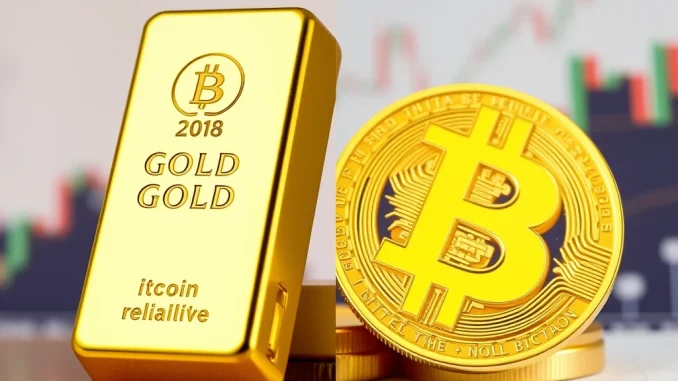
Is Bitcoin a digital gold, or just a flash in the pan? Fidelity’s global macro head, Jurrien Timmer, recently weighed in on the ongoing debate, sparking fresh discussions about the true nature of Bitcoin and its place alongside traditional safe havens like gold. Timmer’s insights offer a compelling perspective for anyone navigating the volatile world of cryptocurrency and seeking a balanced approach to wealth preservation. Let’s dive into what he had to say and unpack the implications for your investment strategy.
Is Bitcoin Really a Speculative Asset Compared to Gold?
In a concise yet impactful post on X (formerly Twitter), Jurrien Timmer shared his views on the evolving roles of gold and Bitcoin as stores of value. He drew a distinct line between the two, labeling gold as “reliable hard money” and Bitcoin as a more complex entity: “both a speculative asset and an emerging store of value.” Timmer’s analogy of Dr. Jekyll and Mr. Hyde paints a vivid picture of Bitcoin’s dual nature – its potential for growth and innovation intertwined with inherent unpredictability.
But what exactly does Timmer mean by ‘speculative’ and ‘reliable’ in this context? Let’s break it down:
- Gold: The Reliable Hard Money: Gold has been a recognized store of value for millennia. Its reliability stems from its physical scarcity, historical acceptance, and role as a hedge against inflation and economic uncertainty. Gold’s price movements are generally less volatile compared to assets like Bitcoin, making it a traditional choice for those seeking stability.
- Bitcoin: The Speculative and Emerging Store of Value: Bitcoin, on the other hand, is a relatively new asset class, born just over a decade ago. Its value proposition as a store of value is still developing. Timmer highlights its speculative nature due to its price volatility and dependence on technological advancements, regulatory landscapes, and market sentiment. However, he also acknowledges its potential as an ’emerging store of value,’ hinting at its growing adoption and increasing recognition as a digital alternative to traditional assets.
[img] Image of a balanced scale with gold bars on one side and Bitcoin logo on the other [/img]
Fidelity’s Timmer suggests a balanced approach to value preservation, considering both Gold and Bitcoin.
Understanding the ‘Store of Value’ Narrative: Gold vs. Bitcoin
The concept of a “store of value” is central to understanding the comparison between gold and Bitcoin. A store of value is an asset that maintains its purchasing power over time. Historically, gold has excelled in this role, particularly during periods of economic turmoil. But how does Bitcoin measure up?
Here’s a comparative look at gold and Bitcoin as stores of value:
| Feature | Gold | Bitcoin |
|---|---|---|
| Age & History | Millennia of history as a store of value | Emerging asset, around a decade old |
| Volatility | Relatively low volatility | High volatility, price swings are common |
| Physical vs. Digital | Physical asset, tangible | Digital asset, intangible |
| Scarcity | Physically scarce, limited supply | Digitally scarce, capped at 21 million coins |
| Adoption | Globally recognized, widespread adoption across institutions and individuals | Growing adoption, but still less mainstream than gold |
| Regulation | Established regulatory frameworks | Evolving and often uncertain regulatory landscape |
Timmer’s perspective acknowledges that while Bitcoin is still in its nascent stage as a store of value, its potential is undeniable. The digital age demands digital assets, and Bitcoin, with its decentralized nature and limited supply, presents a compelling alternative in a rapidly changing financial world.
Why Fidelity’s Macro Strategist Recommends Holding Both Gold and Bitcoin?
Timmer’s suggestion to hold both gold and Bitcoin for “balanced value preservation” is a crucial takeaway. This isn’t about choosing one over the other, but rather recognizing their complementary roles in a diversified portfolio. Here’s why this balanced approach makes sense:
- Diversification Benefits: Combining gold and Bitcoin can enhance portfolio diversification. Their price movements are not perfectly correlated, meaning they may react differently to market events. This can help mitigate risk and improve overall portfolio stability.
- Hedging Against Different Risks: Gold traditionally acts as a hedge against inflation and economic downturns. Bitcoin, while still proving its long-term hedging capabilities, is increasingly seen as a hedge against monetary debasement and traditional financial system risks.
- Capturing Growth Potential: While gold offers stability, Bitcoin presents significant growth potential. Its adoption is expanding, and technological advancements in the blockchain space could further drive its value. Holding both allows investors to participate in potential upside while maintaining a degree of safety.
- Adapting to a Changing World: The global financial landscape is evolving rapidly. Embracing both traditional assets like gold and innovative assets like Bitcoin can be a pragmatic strategy to navigate uncertainty and position oneself for future economic shifts.
Actionable Insights: How to Implement a Balanced Gold and Bitcoin Strategy
So, how can you put Timmer’s advice into practice? Here are some actionable insights:
- Determine Your Risk Tolerance: Assess your comfort level with volatility. Bitcoin’s price swings can be significant, so ensure your allocation aligns with your risk appetite. Gold, being less volatile, can provide a ballast in your portfolio.
- Allocate Strategically: Consider allocating a portion of your portfolio to both gold and Bitcoin. The specific allocation will depend on your investment goals, risk tolerance, and time horizon. A common approach is to allocate a smaller percentage to Bitcoin due to its higher risk profile and a larger percentage to gold for stability.
- Stay Informed: The cryptocurrency market is dynamic. Keep abreast of developments in the Bitcoin and broader crypto space. Similarly, monitor economic indicators that can influence gold prices.
- Consider Professional Advice: If you are unsure how to integrate gold and Bitcoin into your investment strategy, consult with a financial advisor. They can provide personalized guidance based on your specific circumstances.
Conclusion: Embracing the Dual Nature of Value Preservation
Jurrien Timmer’s perspective offers a nuanced understanding of gold and Bitcoin in today’s financial world. He doesn’t dismiss Bitcoin as purely speculative but acknowledges its evolving role as an emerging store of value. By recognizing the distinct characteristics of both gold and Bitcoin, investors can craft a more robust and balanced strategy for value preservation. The key takeaway? In a world of financial uncertainty, perhaps the most powerful approach is not to choose sides, but to strategically embrace the strengths of both traditional and innovative assets. Timmer’s balanced approach could be the golden ticket to navigating the complexities of modern investing and securing your financial future.



